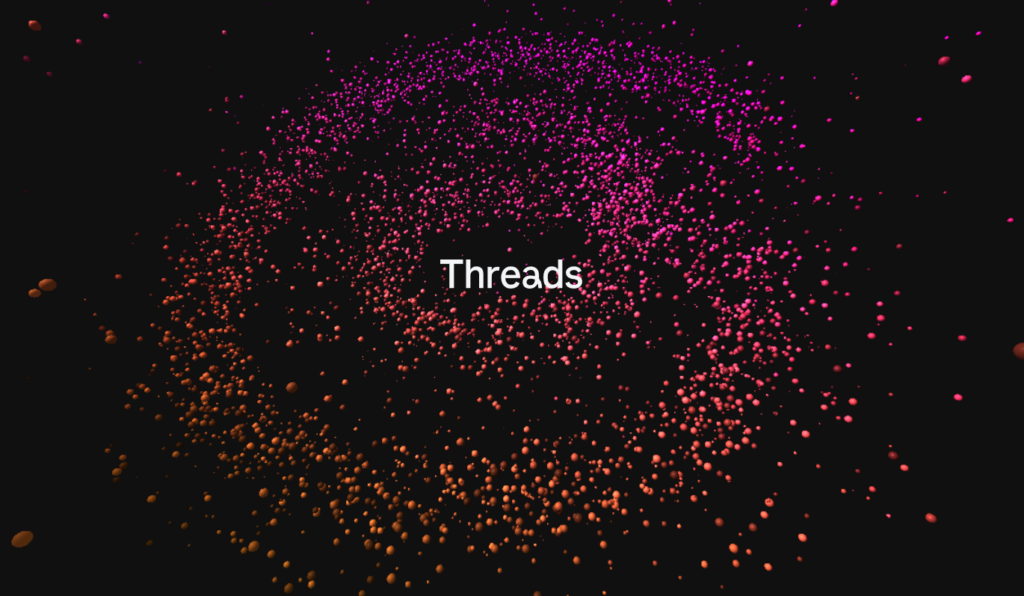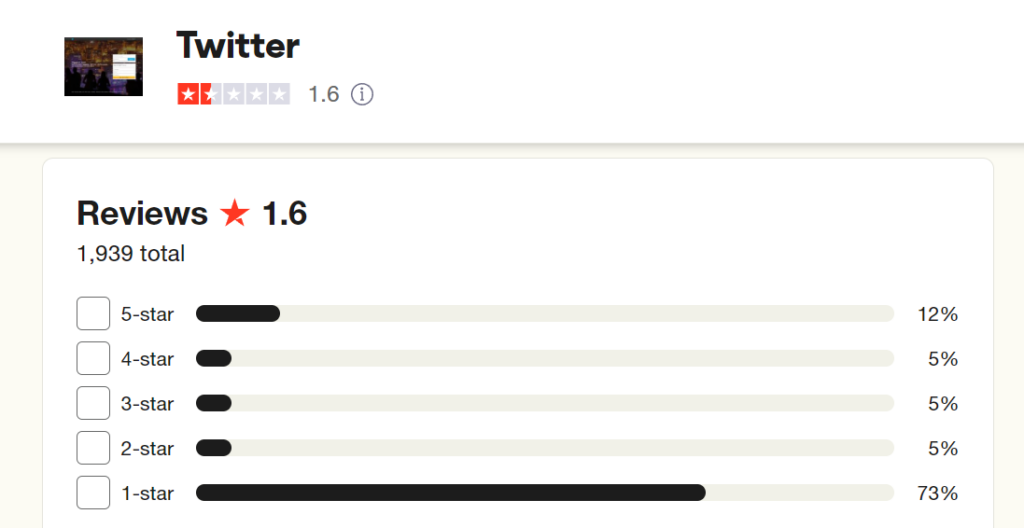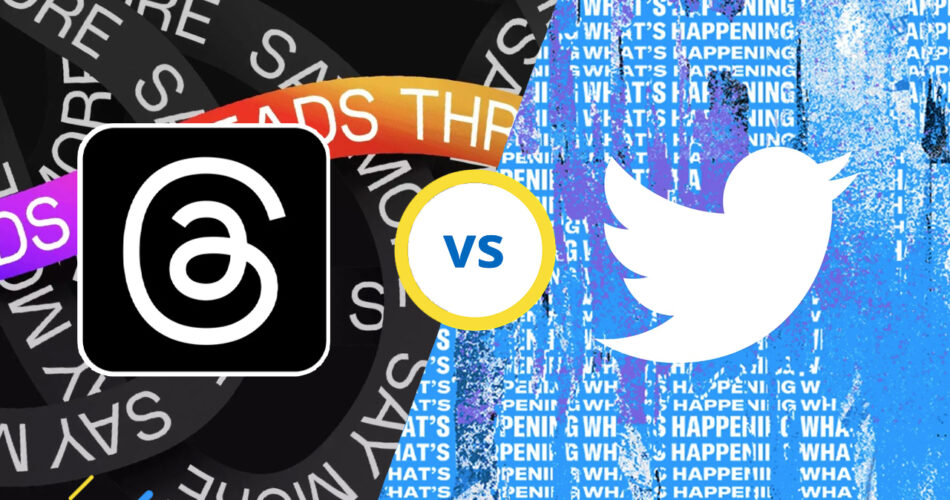In the ever-evolving world of social media, the “Threads vs Twitter” debate is shaping our digital future. As two powerful platforms, Twitter and Threads have become the talk of the town, each offering unique features and experiences. But which one is truly the superior platform? Let’s dive in and find out.
Table of Contents
Twitter Overview

A Brief History of Twitter
Twitter, a microblogging and social networking site, was launched in 2006 by Jack Dorsey, Biz Stone, and Evan Williams. The platform was born out of a brainstorming session at Odeo, a podcasting company co-founded by Williams. The initial idea was to create an SMS-based platform where a user could communicate with a small group, which later evolved into a global platform for public self-expression and conversation in real time.
In a significant development in 2023, Elon Musk, the CEO of Tesla and SpaceX, became the largest shareholder of Twitter. Musk, known for his active and sometimes controversial presence on Twitter, has often shared his ideas for improving the platform. His acquisition of a significant stake in Twitter has led to speculation about potential changes and innovations that could shape the future of the platform.
Key Features and Functionalities of Twitter
Twitter is known for its unique features that have shaped the way we communicate online. The primary feature is the “Tweet,” which is a post of up to 280 characters that users can post on their profile. Other users can then “retweet,” “like,” or reply to these tweets, fostering interaction and discussion.
Twitter also introduced “hashtags” (#), a tagging system that allows users to follow specific topics or discussions. This feature has been instrumental in creating viral trends and global movements.

In recent years, Twitter has introduced new features like “Twitter Spaces,” a platform for live audio conversations, and “Fleets,” a feature for sharing ephemeral content that disappears after 24 hours, similar to Instagram Stories.
Twitter User Demographics and Statistics
As of 2023, Twitter boasts over 330 million monthly active users worldwide, making it one of the most popular social media platforms. The user base is diverse, with a nearly equal distribution of male and female users. The largest age group on Twitter is between 25 and 34 years old, making it a popular platform among millennials.
Geographically, the United States has the highest number of Twitter users, followed by Japan and India. English is the most used language on the platform.
Twitter’s Success Stories
Twitter has been instrumental in several global movements and events. For instance, it played a significant role in the 2008 U.S. Presidential election, where Barack Obama‘s campaign used the platform for outreach and engagement.
The platform has also seen numerous viral trends, such as the #IceBucketChallenge for ALS awareness, and movements like #BlackLivesMatter and #MeToo, demonstrating its power in mobilizing public opinion and action.
Threads.net Overview

The Emergence of Threads
Threads, a new social platform from Meta (formerly Facebook Inc.), was launched with the aim of fostering more intimate and focused conversations. Unlike traditional social media platforms that are often cluttered with a wide array of content, Threads is designed to create a space for deeper, more meaningful interactions.
Key Features and Functionalities of Threads
One of the defining features of Threads is the ability to create sub-threads. This allows users to have nested conversations within a larger thread, making discussions more organized and easier to follow.
Another unique feature is the high level of control it gives users over their conversations. Users can choose who can participate in a thread, making it a more private and secure platform for discussions.
Threads also offers features like rich text formatting and the ability to share various types of media, including images, videos, and links, within a thread. This makes the conversation more engaging and dynamic.
Threads User Demographics and Statistics
Being a relatively new platform, Threads is still in the process of building its user base. However, it’s rapidly gaining popularity, particularly among users who value privacy and meaningful conversations over the noise and clutter of traditional social media platforms.
While exact user demographics and statistics are not yet available, early adopters of Threads seem to be a diverse group, including professionals seeking focused discussions, educators and students looking for a platform for academic discussions, and individuals who value privacy and meaningful social interactions.
Who Has Joined the Threads Network?
Post by @jloView on Threads
Among the celebrities who have registered on Threads are renowned figures such as Gordon Ramsay, Shakira, and Jennifer Lopez. Major news organizations and brands joined them within hours of the platform’s launch. Mark Zuckerberg, who had long been inactive on his Twitter account, has been actively posting messages since the launch of Threads.
Comparative Analysis

To provide a clear comparison between Threads and Twitter, let’s look at various aspects.
Comparison Chart 1
| Aspect | Threads | |
|---|---|---|
| Whom Belongs | As of 2023, Elon Musk is the largest shareholder of Twitter. | Threads is owned by Meta Platforms Inc., formerly known as Facebook Inc. |
| Launched In | Twitter was launched in 2006. | Threads was launched in 2023. |
| Users | As of 2023, Twitter has over 330 million monthly active users worldwide. | In just the first days, the platform attracted over 100 million users. |
| Average Time Spent on Twitter Per Day | 21 minutes | 7 minutes |
| Estimated Worth | As of 2023, Twitter’s market capitalization is approximately $40 billion. | As a part of Meta Platforms Inc., Threads’ individual worth is not publicly disclosed. |
| Post Character Limit | Twitter has a character limit of 280 for each tweet. | 500 for each post. |
| Post edit | No | In Twitter Blue (paid version) |
| Verification | No | In Twitter Blue (paid version) |
| Hashtags | No | Yes |
| Direct Messages | No | Yes |
| Video Limit | Twitter allows videos up to 2 minutes and 20 seconds in length. | 5 minutes. |
| Embedding | Yes | Yes |
| Platforms Supported | Twitter is available on web, iOS, and Android. | Threads is available on iOS, and Android. |
Comparison Chart 2
| Aspect | Threads | |
|---|---|---|
| User Interface | Twitter has a simple and straightforward interface. It’s designed for quick browsing and real-time updates. | Threads offers a more intimate and focused layout. It’s designed for deeper, more organized conversations. |
| Features | Twitter’s main features include tweets, retweets, likes, hashtags, Twitter Spaces, and Fleets. | Threads’ key features include sub-threads, privacy controls, rich text formatting, and media sharing within threads. |
| User Demographics | Twitter has a diverse user base of over 330 million, spread across various age groups, professions, and locations. | Threads is still building its user base. Early adopters include professionals, educators, students, and individuals who value privacy and meaningful conversations. |
| Use Cases | Twitter is ideal for real-time updates, viral content, news, and public conversations. | Threads is perfect for focused discussions, and deeper social interactions. |
| Privacy and Security | Twitter offers privacy settings and security measures, but the platform is largely public and open. | Threads places a greater emphasis on privacy, giving users more control over their conversations and who can participate in them. |
User Interface Comparison


Twitter’s interface is designed for quick, real-time updates. It’s easy to browse, allowing users to quickly scroll through tweets, retweets, and trending topics. On the other hand, Threads offers a more intimate and focused layout. It’s designed for deeper, more organized conversations, making it easier to follow and participate in discussions.
Feature Comparison
Twitter’s main features are designed for quick, public interactions. This includes tweets, retweets, likes, and hashtags. Twitter also offers features like Twitter Spaces for live audio conversations and Fleets for ephemeral content. Threads, however, offers features like sub-threads for nested conversations, privacy controls for more private discussions, and rich text formatting and media sharing to make conversations more engaging.
User Demographic Comparison
Twitter has a diverse user base of over 330 million users worldwide, making it a popular platform among various age groups, professions, and locations. Threads, being a newer platform, is still building its user base. However, it’s rapidly gaining popularity among users who value privacy and meaningful conversations.
Use Case Comparison
Twitter is ideal for real-time updates, viral content, and public conversations. It’s a platform where news breaks and trends start. Threads, on the other hand, is perfect for focused discussions and private conversations. It’s a platform for deeper, more meaningful social interactions.
Privacy and Security Comparison
While both platforms take privacy and security seriously, Threads places a greater emphasis on these aspects. It gives users more control over their conversations and who can participate in them, making it a more private and secure platform for discussions.
Who Are the Users of Twitter and Threads and Why?

Twitter Users
Twitter has a diverse user base that spans across various age groups, professions, and locations. The platform is popular among journalists, politicians, celebrities, and everyday users who use it to share their thoughts, follow news and trends, and engage in public discourse.
- News Enthusiasts: Twitter is known for its real-time updates, making it a go-to platform for people who want to stay updated with the latest news and events.
- Celebrities and Public Figures: Many celebrities, athletes, politicians, and other public figures use Twitter to communicate directly with their fans and followers, share updates, and express their opinions.
- Businesses and Marketers: Businesses use Twitter for marketing, customer service, and brand building. The platform’s wide reach and real-time nature make it an effective tool for businesses to engage with their customers and promote their products or services.
- General Users: Everyday users use Twitter to express their thoughts, follow their interests, and engage in conversations.
Threads Users
Being a newer platform, Threads is still building its user base. However, it’s rapidly gaining popularity among users who value privacy and meaningful conversations.
- Privacy-Conscious Users: Threads places a greater emphasis on privacy, giving users more control over their conversations and who can participate in them. This makes it appealing to users who prefer more private and secure platforms for discussions.
- Professionals and Educators: Threads’ focus on deeper, more organized conversations makes it a useful tool for professionals and educators. They can use Threads to have detailed discussions, collaborate on ideas, and share knowledge.
- Businesses: Like Twitter, businesses can also use Threads to engage with their customers. However, the interactions on Threads are likely to be more in-depth and focused, allowing businesses to build stronger relationships with their customers.
- General Users: Everyday users who prefer more intimate and focused social interactions over quick, real-time updates may find Threads more appealing.
User Experience Reviews: Threads vs Twitter

Based on the people reviews gathered from Twitter and Trustpilot, here’s a summary of user experiences on both platforms:
Threads
As a newer platform, Threads is still in the process of refining its features and improving its user experience. Some users have reported issues with app stability, suggesting that there may be technical bugs that need to be addressed. The platform’s focus on deeper, more meaningful conversations is appreciated, but it seems that improvements in stability and user interface could enhance the overall user experience.
Everyone running back to Twitter after trying Threads App for 5 Min 😂#Threads #ThreadsApp #ElonMusk#MarkZuckerberg #ElonVsZuckerberg #ElonMusk pic.twitter.com/XXHw8OKmY0
— Yash Barapatre (@nikunimje) July 7, 2023

On Trustpilot, Twitter has a rating of 1.6 out of 5, indicating a generally negative user experience. Some of the common complaints include:
- Censorship and violation of free speech: Several users have expressed frustration about being banned or restricted for expressing their opinions.
- Poor functionality: Users have reported issues with videos not loading, session timeouts, and changes to personal account settings.
- Increased spam: Some users have noticed an increase in spam messages since Elon Musk took over.
- Negative changes under new management: Many users feel that the platform has worsened under Elon Musk’s ownership, with some calling for the platform to be sold.
- Lack of customer support: Users who have had their accounts hacked or encountered other issues have reported a lack of support from Twitter.
However, there are also positive reviews. Some users appreciate Twitter for its global reach and the ability to communicate messages to a wide audience. Others enjoy the platform’s ability to keep them updated on global happenings.
Impact on Businesses and Marketing
In today’s digital age, social media platforms like Twitter and Threads have a significant impact on businesses and marketing. They offer unique opportunities for businesses to engage with their customers, promote their products or services, and build their brand.
Leveraging Twitter for Business
Twitter offers businesses a platform for real-time engagement with their customers. Businesses can use Twitter to share updates, promote products or services, and provide customer service. The platform’s real-time nature makes it ideal for timely promotions and updates.
Twitter’s hashtag feature also allows businesses to participate in or start trending topics, increasing their visibility and reach. Additionally, businesses can use Twitter’s advertising platform to target specific demographics, further enhancing their marketing efforts.
Leveraging Threads for Business
Threads offers a different kind of value for businesses. Its focus on deeper, more meaningful conversations allows businesses to build stronger relationships with their customers. Businesses can use Threads to have detailed discussions about their products or services, gather in-depth feedback, and foster a community around their brand.
The platform’s privacy features also make it a safe space for businesses to have sensitive discussions, such as product development ideas or customer service issues.
Successful Marketing Campaigns
Both Twitter and Threads have seen successful marketing campaigns. On Twitter, businesses have leveraged trending hashtags to gain visibility and engage with a larger audience. For example, the #ShareACoke campaign by Coca-Cola, which encouraged users to share pictures of their personalized Coke bottles, was a massive success on Twitter.
On Threads, businesses have leveraged the platform’s focus on meaningful conversations to engage their customers on a deeper level. For instance, a business could start a thread discussing the features of a new product, inviting customers to ask questions and share their feedback. This not only provides the business with valuable insights but also makes the customers feel heard and valued.
Impact on Crypto Market and Communities

Social media platforms like Twitter and Threads have a significant impact on the crypto market and communities. They serve as important channels for information dissemination, community building, and market sentiment analysis.
Twitter’s Impact on Crypto Market and Communities
Twitter has long been a major platform for crypto-related discussions. Many prominent figures in the crypto world, including developers, influencers, and even CEOs of major crypto companies, are active on Twitter. They use the platform to share updates, discuss ideas, and interact with the community.
Crypto-related hashtags often trend on Twitter, reflecting the sentiment and interest level of the wider public. For instance, hashtags like #Bitcoin and #Ethereum can trend during major market movements, indicating the level of interest and activity around these cryptocurrencies.
This is what will happen once the BlackRock Spot #Bitcoin ETF gets accepted: pic.twitter.com/XxcNCbL2Fa
— Mister Crypto (@misterrcrypto) July 7, 2023
Moreover, Twitter has been used for various crypto marketing campaigns. For example, many Initial Coin Offerings (ICOs) and token sales have been promoted on Twitter, reaching a wide audience.
Threads’ Impact on Crypto Market and Communities
Threads, with its focus on deeper, more meaningful conversations, offers a different kind of value for the crypto community. It provides a space for in-depth discussions about complex topics related to blockchain technology, cryptocurrencies, and decentralized finance.
Crypto developers and enthusiasts can use Threads to have detailed discussions about new projects, share in-depth analyses, and collaborate on ideas. The platform’s privacy features also make it a safe space for sensitive discussions, such as those related to crypto development or investment strategies.
Future Predictions for Crypto Communities on Social Media
As the crypto market continues to grow, we can expect social media’s role in the crypto community to evolve as well. Platforms like Twitter and Threads will continue to be important spaces for information sharing, discussion, and community building.
We may see more crypto-focused features on these platforms. For example, Twitter has already started experimenting with Bitcoin tips, allowing users to send and receive Bitcoin directly on the platform. Threads could also introduce crypto-related features, such as integrations with crypto wallets or blockchain-based identity systems.
Time Taken to Reach First 10 Million Users
| Service | Time to Reach 10 Million Users | What It Does |
|---|---|---|
| Threads | 7 hours | Threads is a social platform from Meta that focuses on fostering more intimate and focused conversations. |
| ChatGPT | 40 days | ChatGPT is a language model developed by OpenAI that can generate human-like text based on the input it receives. |
| Clubhouse | 347 days | Clubhouse is a social networking app based on audio-chat. Users can listen in to conversations, interviews, and discussions between interesting people on various topics. |
| 355 days | Instagram is a photo and video sharing social networking service owned by Meta. It allows users to upload media that can be edited with filters and organized with tags and location information. | |
| 780 days | Twitter is a microblogging and social networking site where users post and interact with messages known as “tweets.” | |
| 852 days | Facebook is a social networking site where users can post comments, share photographs and links to news or other interesting content on the web, chat live, and watch short-form video. |
Please note that the time taken to reach the first 10 million users can vary greatly depending on various factors, including the nature of the service, the marketing strategies used, and the overall market conditions at the time of launch.
Future Predictions
As social media continues to evolve, it’s interesting to speculate about the future of platforms like Twitter and Threads. Both platforms are likely to continue innovating and adapting to meet the changing needs of their users.
Upcoming Features and Updates for Twitter
Twitter has shown a commitment to innovation and adaptation. The platform has introduced several new features in recent years, such as Twitter Spaces for live audio conversations and Fleets for ephemeral content.
In the future, we can expect Twitter to continue this trend. The platform may introduce more interactive features to enhance user engagement. There’s also a possibility of Twitter further integrating e-commerce and live-streaming features, following the trend of social commerce.
Upcoming Features and Updates for Threads
Being a newer platform, Threads has a lot of potential for growth and innovation. The platform is likely to introduce new features to enhance user experience and engagement. This could include more options for customization, improved search and discovery features, and more tools for moderating and controlling conversations.
Threads may also focus on expanding its user base. This could involve partnerships with other platforms or companies, promotional campaigns, and efforts to attract influencers and thought leaders to the platform.
Predicted Trends in the Social Media Landscape
The “Threads vs Twitter” debate represents a larger trend in the social media landscape. On one hand, there’s a demand for real-time updates and public conversations, as seen on Twitter. On the other hand, there’s a growing desire for more intimate, meaningful social interactions, as seen on Threads.
In the future, we can expect to see more platforms trying to balance these two aspects. There may be more crossover between public and private social media spaces, and more emphasis on user control and customization.
Conclusion
In the “Threads vs Twitter” debate, it’s clear that both platforms have unique strengths and cater to different user needs. As we move forward, it will be interesting to see how these platforms evolve and shape our social media future. So, why not try both and see which one suits your needs best?
FAQs
How does Twitter compare to Threads?
While both Twitter and Threads are social platforms, they offer different experiences. Twitter is designed for quick, real-time updates and public conversations. Threads, on the other hand, is designed for deeper, more organized conversations. It gives users more control over their conversations and who can participate in them.
How can businesses leverage Twitter and Threads?
Businesses can use Twitter to share updates, promote products or services, and provide customer service. The platform’s real-time nature makes it ideal for timely promotions and updates. Threads, on the other hand, allows businesses to have detailed discussions about their products or services, gather in-depth feedback, and foster a community around their brand.
What are the future predictions for Twitter and Threads?
Both Twitter and Threads are likely to continue innovating and adapting to meet the changing needs of their users. Twitter may introduce more interactive features to enhance user engagement and further integrate e-commerce and live-streaming features. Threads, being a newer platform, is likely to introduce new features to enhance user experience and engagement, and focus on expanding its user base.


